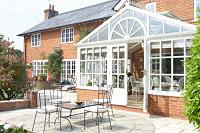- Home
- Planning Information
- Home Extensions
- Conservatories and Rear Extensions
Conservatories and Rear Extensions

Benefits
- Increased living space
- A predominantly glazed structure brings the garden into your home particularly if you have a complimentary patio area
- A predominantly glazed structure offers an ambient light
N.B. Planning Permission for Extensions is not always required
 Do I Need Planning Permission?
Do I Need Planning Permission?
Planning Permission may not be required subject to the following limits and conditions:
- No more than half the area of land around the original house* would be covered by additions or other buildings.
- No extension forward of the principal elevation or side elevation fronting a highway.
- No extension to be higher than the highest part of the roof.
- Maximum depth of a single-storey rear extension of 3 metres for an attached house and 4 metres for a detached house.
- Maximum height of a single storey rear extension of 4 metres.
- Maximum depth of a rear extension of more than 1 storey of 3 metres including ground floor.
- Maximum eaves height of an extension within 2 metres of a boundary of 3 metres.
- Maximum eaves and ridge height of extension no higher than existing house.
- Side extensions to be single storey with maximum height of 4 metres and width no more than half that of the original house.
- Roof pitch of extensions higher than 1 storey to match existing house.
- No verandas, balconies or raised platforms.
- On designated land* no permitted development for rear extensions of more than 1 storey; no cladding of the exterior; no side extensions.
* The term "original house" means the house as it was first built or as it stood on 1 July 1948 (if it was built before that date). Although you may not have built an extension to the house, a previous owner may have done so.
* Designated land includes national parks and the Broads, Areas of Outstanding Natural Beauty, conservation areas and World Heritage Sites